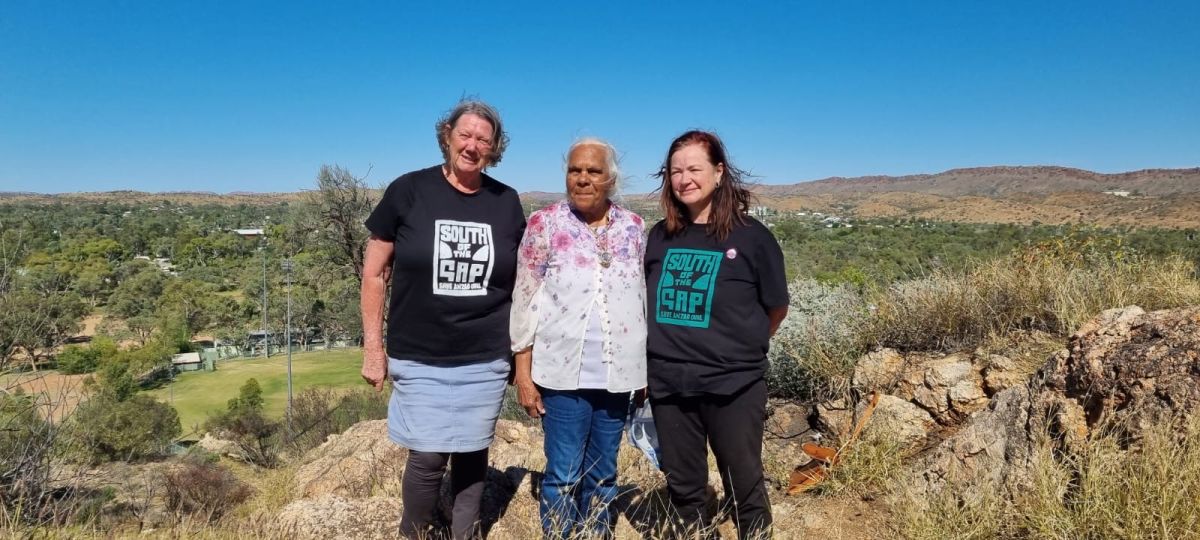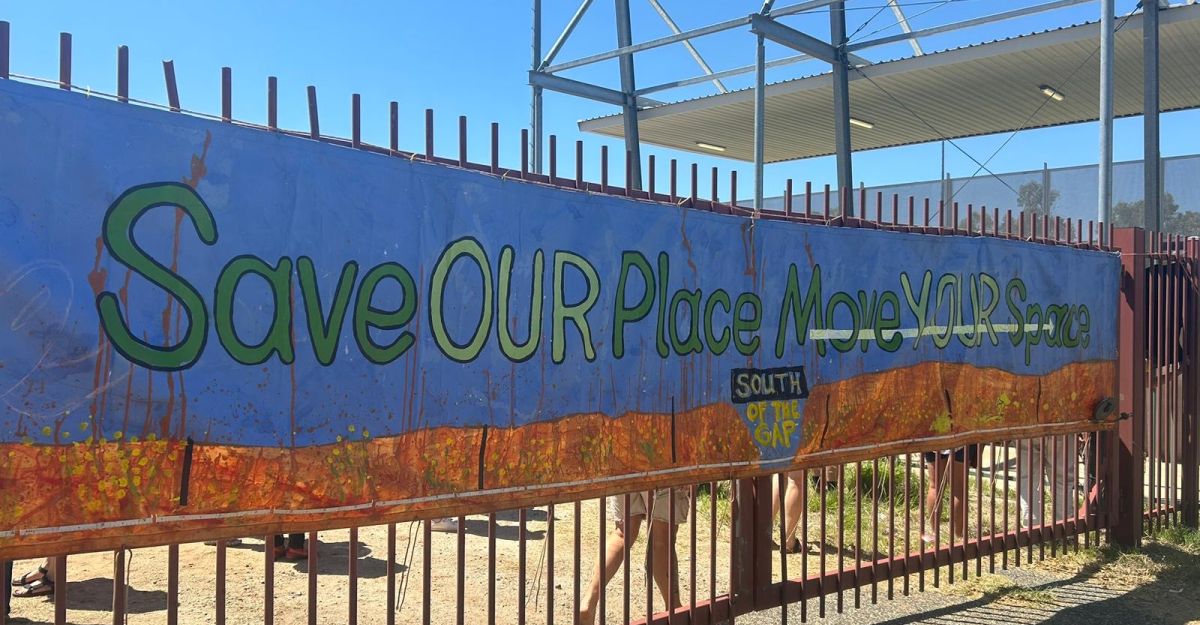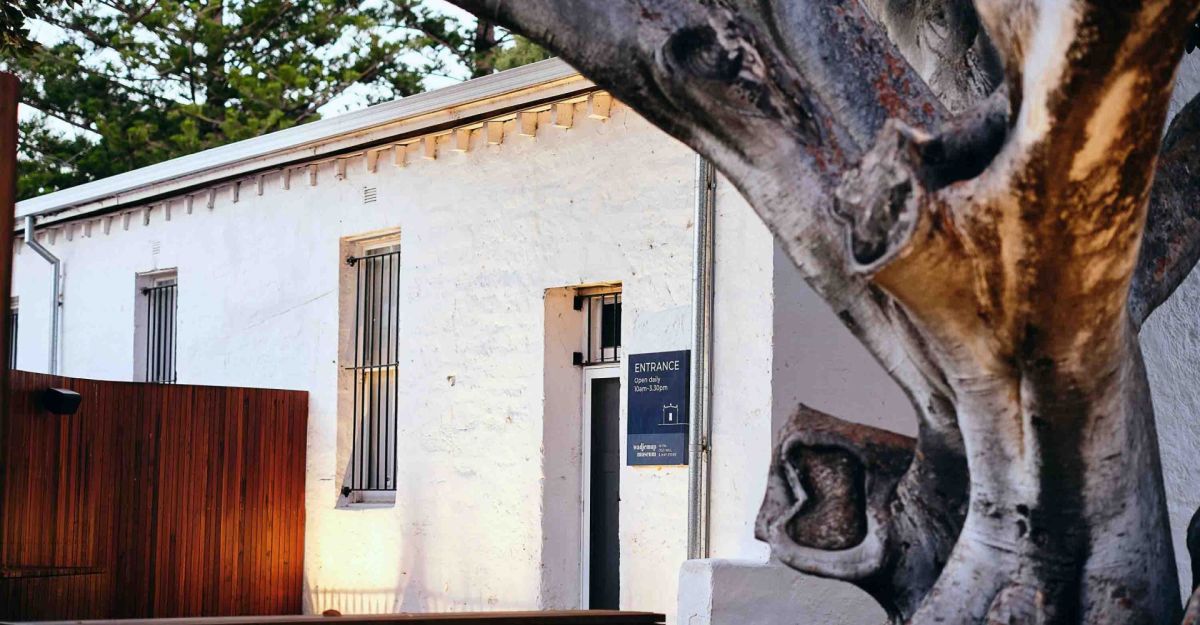This article is dedicated to Harold Furber who irrepressibly campaigned for a National Aboriginal and Torres Strait Islander Cultural Center to be built on Arrernte country up until his death.
In the before times, Central Arrernte warriors would guard ntaripe — that staggering parting of the range, known in Arrernte country now as “the gap”. They determined who could pass, according to the law. Only artwe — initiated men — could move through. Others had to go east or west via other gorges.
Visitors from other language groups undertook signalling, gifting, waiting. They practiced the law before the right to pass was granted. The transgression of this sacred threshold — first by Stuart and his exploring party, then by settlers in ever increasing numbers, has accelerated to a constant rush of traffic all day in both directions. This is just one, albeit potent, desecration of law that Arrernte people have endured since arrival, engendering all manner of immense embarrassment, shame and grief that largely goes unregistered.
One can follow a hyperlinked trail of articles online describing an “ill-fated”, “doomed”, “stalled”, “all but dead and buried”, “controversy-plagued” National Aboriginal Art Gallery project and a tawdry saga of dissent that has played out here in Arrernte country. And yet, somehow, in July 2024 the fences have gone up around the building site for what is now called the Aboriginal and Torres Strait Islander Art Gallery of Australia (ATSIAGA). This is planned for the center of Alice Springs township at the women’s site known as Untyeyetwelye and across the adjacent public recreational site known as Anzac Oval.
A vast majority of Arrernte custodians for Mparntwe have expressed opposition to the project on this site at every stage, but like so many instances before it, the government have sought out a few voices who assent, called it consultation and run with it. The original steering committee involved veterans like Hetti Perkins and Phillip Watkins, but their recommendations, particularly on the question of location, were ignored, and they walked away.
It’s claiming national status, but on the ground, we’re uncertain who across this continent has heard of this looming apparition. It seems in essence to be a tourism scheme by the Northern Territory Government, laden with appealing jargon, pasted over the spectre of truer desires and sacred sites, hustled through the well-worn channels of disregard.
There is an older chapter to the originating mythology of this saga that has been obscured. We write to register these ghosts in the architecture and alert a farther-afield readership to the latest wave of grassroots protest happening now.

Warramungu/Luritja man Owen Cole, Central Arrernte man Harold Furber and numerous other local First Nations people committed years researching a vision for a National Aboriginal Art and Culture center that was to tell a story about this continent from a First Nations perspective. They fought in suits and learned to speak the language of entrepreneurship and bureaucracy — no small concession — to propose something on terms that might fly with colonial governments and institutional bodies. These exhausted visionaries’ lifetimes are testimony to an attempt to do something better, more of the place and of the people. Imperfect perhaps, but in the spirit of the apmere (place/country).
This vision for an art and culture center, however, was spat out, ignored and reconstituted as a National Art Gallery — something state-building and grandiose. The, initially, Country Liberal Party NT Government, and subsequently Territory Labour, excised the ‘culture’ component and championed the art.
First Nations’ artistic practices are plurally excellent, animated, vital and cannot be separated as such from culture. But what does it do, to wrest a vision of a locally driven cultural center, complete with the subjectivities, corporealities, histories and living culture of Aboriginal people in multiple class categories, and turn it into a Nationally curated art gallery? For us it implicates a turn toward something more benign and sanitised — something that requires only benevolent appreciation of art objects and little confrontation with complexity or difficulty. A turn away from an encounter that might alight a visitor’s mind to the idea that there is something here that is not immediately able to be understood, something otherwise, something sovereign. It brings to mind Marcia Langton’s observation that ideas of Aboriginality are conceived intersubjectively by a settler state, or Richard Bell’s timeless declaration that Aboriginal Art Is A White Thing. These are notions that are dextrously recuperated and challenged by First Nations artists where possible, but will this be a venue for recuperation, or perpetuation? What versions of Aboriginality will be allowed to breathe here?
As of late August, the Territory has voted in the first Country Liberal Party government for eight years. Within two days, the new chief minister hit the media promising to crack down on law and order, to lower the age of criminal responsibility and to reinstate the use of spit hoods on children in detention. It’s a popularity flex toward the fierce conservative body alive and well in the Territory. These methods have been disproven countless times, linked with deaths in custody, increases in reoffending and the further traumatisation of vulnerable young people.
ATSIAGA planning documents claim to ensure “that the gallery serves as a vibrant hub for the community.” This reads nicely to imply — everyone — but “community” is and was always a term wantonly instrumentalised to do service to the status quo, or liberal fantasies of harmony. Miranda Joseph writes “community is always invoked as an unequivocal good, an indicator of a high quality of life, a life of human understanding, caring, selflessness, belonging.” Leaving no room for critical agonism, “community”, deployed as a singular entity, excludes with the language of inclusion. SJ Norman wonders “Who can say ‘community’ in 2024 with a straight face?”
We are no strangers to the way Alice Springs institutions train staff in suspicion toward young Aboriginal people. A grim saga at the Alice Springs Public Library saw workers bullied, suspended, fired — muscled out following a sustained attempt to create safe and engaging spaces for young people. There exists a profound lack of will and imagination toward tackling the real and compounding reality of violent tensions on our streets. The police are experienced by many people in Central Australia as a violent and antagonising force. Extremely traumatised and angry young people are repeatedly weaponised for the political gain of both local and national forces. The willful dehumanisation perpetuated by certain media outlets serve domination and extraction. With NT local councils and governments alike hell bent on policies that sanitise public space for tourism, we question whether this could ever be a safe place for young Aboriginal people, when the most profoundly challenging, hopeful and radical thing that could be done is to build a living public institution by, for and with them. We need bold and sustained local projects that seek to repair intergenerational wounds from the foundations.
We wryly wish the project was still going by the name “NAAG” (National Aboriginal Art Gallery). Maybe A SAGA can be extracted from the new acronym? It’s a boring, acrid poetic but it’s what we have in abundance — acronyms that avoid specificity or personality, diluted into the haze (think Alexis Wright’s Praiseworthy) of unknowability, not offending anyone in particular while offending almost everyone equally. On every front we see the rampant uptake and co-option of the languages of resistance into the policy speak of institutions — “cultural safety” hidden behind to avoid taking a stance on Palestine (see Brooks and Lorange, in the current issue of Overland); “decolonization” — famously not a metaphor — metaphorically deployed by every arts bureaucrat who ever dreamt of a nice feeling; “diversity” bringing colour to the land as a KPI by numbers, sending “the different” into an embattled frontline toward actual praxis or institutional change. The result is a convoluted discursive minefield which leaves little refuge for self-definition, when all the cogent terms have been obfuscated toward meaninglessness. Language can be trusted to reinvent, but the latency and its material artefacts are concrete and steel that a public is left to cop.
There is a palpable fatigue in Alice Springs to the kind of willful indifference shown incessantly to expressions of sovereignty from Arrernte people. Some are so exhausted from being ignored, that they simply become impossible to contact, elusive, declining comment. Despite this, after years of protesting this gallery, a new group have gathered since the construction fences went up, hoping that a final push could at least move the project to where a majority of custodians would prefer it — south of that sacred threshold and closer in line with Harold and Owen’s vision.
The current campaign — brought together by the banner SOUTH OF THE GAP — has generously elected to focus on the site as the crux of their ill ease, and the oval is described as a heritage site for both black and white, given its long history as a sporting and recreational venue. The government’s compulsory acquisition of the land has been characterised by many as theft. As we were writing this piece, the new CLP government announced they would halt building to “save the oval” — appeasing the rugby community while still indicating they will build it at the women’s site, against Arrernte wishes. We wonder if building it south of the gap would spell the end of the project; if it couldn’t maintain the fantasy held by powerful business and real estate lobby groups for the flow of tourist dollars toward the town center.
Apmereke-artweye (relation and custodian of country) Doris Kngwarraye Stuart is a crucial opponent and weary from her legacy of resistance to infrastructural impositions on sacred country. Labelled by the local development establishment as cranky and anti-progress, she has been acknowledged by many others as beautifully embodying an ethic of negation and refusal. She has hosted bus tours attending to sacred sites that have been variously built over, detonated and near erased from collective memory. Her son-nephew Farron Peckham is a key driver of the current activity. A women’s gathering took place on a Sunday in early September to demonstrate opposition from the matriarchy whose site is in question. It feels like watching live as identities shape themselves around resistance and belonging. To a nation state that demands some static truth about the sacred past, we welcome a possibility to reassert specificity and belonging in the present moment, when coherence has been gouged at so many instances along the colonial continuum. Do not underestimate the power of Arrernte women, who have protected sacred sites from mitigation dams, a uranium mine, countless other threats, and laboured endlessly to hold on to language and ceremony.
We know what it is to collaborate long-term to create public facing spaces in Alice Springs that prioritise Arrernte knowledge. It’s complicated, it’s contested, it’s an unruly space of encounter, where the narratives running through this place are live, and in conflict. These spaces contain the possibility to jolt young Arrernte people out of the sensation that nothing is for them, that an encounter with an institution will be something other than suspicion and hostility.
Could a supposed nation-building project of this scale ever transcend its bad foundation? Are First Nations welcoming the pan-Aboriginality implied by the tenor of this project? Between the lines of all this bad feeling is the sense that we’re not ready for this monument. We hear Harold’s exasperated voice repeating “It’s all back to front!”. On the ground, this gallery is sensed as a structure of ongoing invasion. The last thing the town called Alice Springs and the Country alive beneath it needs, is another monument to the desire of others.



